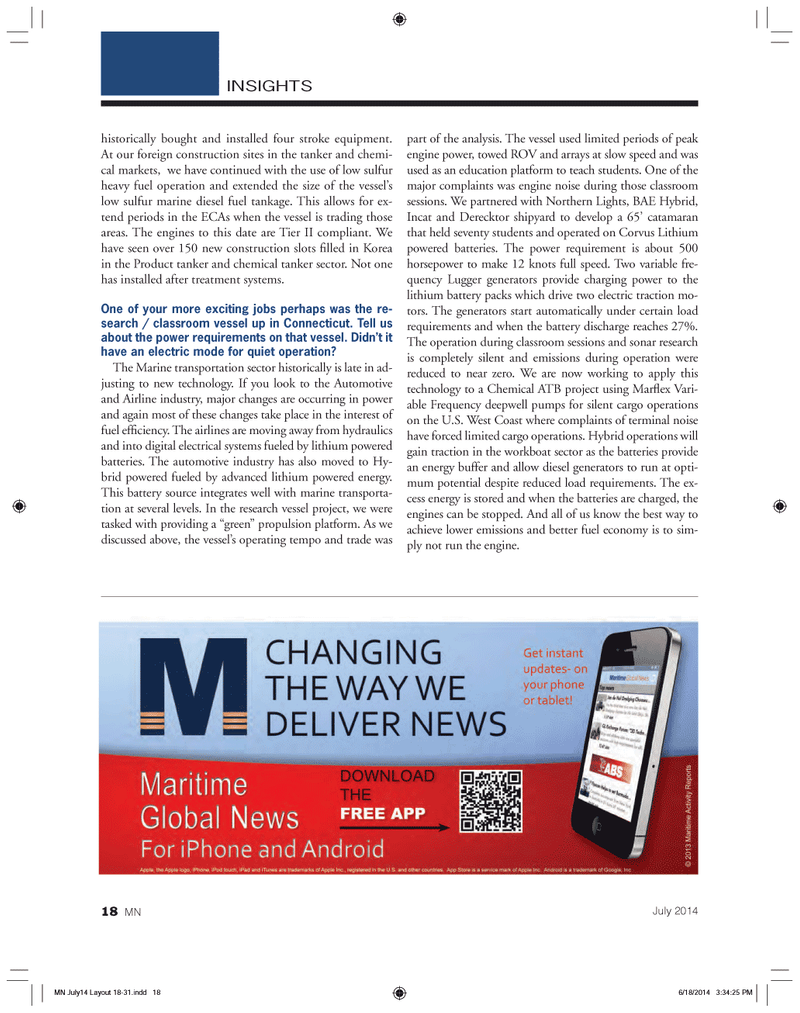
Page 18: of Marine News Magazine (July 2014)
ATB Technical Trends
Read this page in Pdf, Flash or Html5 edition of July 2014 Marine News Magazine
historically bought and installed four stroke equipment. At our foreign construction sites in the tanker and chemi- cal markets, we have continued with the use of low sulfur heavy fuel operation and extended the size of the vessel?s low sulfur marine diesel fuel tankage. This allows for ex- tend periods in the ECAs when the vessel is trading those areas. The engines to this date are Tier II compliant. We have seen over 150 new construction slots lled in Korea in the Product tanker and chemical tanker sector. Not one has installed after treatment systems. One of your more exciting jobs perhaps was the re- search / classroom vessel up in Connecticut. Tell us about the power requirements on that vessel. Didn?t it have an electric mode for quiet operation?The Marine transportation sector historically is late in ad- justing to new technology. If you look to the Automotive and Airline industry, major changes are occurring in power and again most of these changes take place in the interest of fuel ef ciency. The airlines are moving away from hydraulics and into digital electrical systems fueled by lithium powered batteries. The automotive industry has also moved to Hy- brid powered fueled by advanced lithium powered energy. This battery source integrates well with marine transporta- tion at several levels. In the research vessel project, we were tasked with providing a ?green? propulsion platform. As we discussed above, the vessel?s operating tempo and trade was part of the analysis. The vessel used limited periods of peak engine power, towed ROV and arrays at slow speed and was used as an education platform to teach students. One of the major complaints was engine noise during those classroom sessions. We partnered with Northern Lights, BAE Hybrid, Incat and Derecktor shipyard to develop a 65? catamaran that held seventy students and operated on Corvus Lithium powered batteries. The power requirement is about 500 horsepower to make 12 knots full speed. Two variable fre- quency Lugger generators provide charging power to the lithium battery packs which drive two electric traction mo- tors. The generators start automatically under certain load requirements and when the battery discharge reaches 27%. The operation during classroom sessions and sonar research is completely silent and emissions during operation were reduced to near zero. We are now working to apply this technology to a Chemical ATB project using Mar ex Vari- able Frequency deepwell pumps for silent cargo operations on the U.S. West Coast where complaints of terminal noise have forced limited cargo operations. Hybrid operations will gain traction in the workboat sector as the batteries provide an energy buffer and allow diesel generators to run at opti- mum potential despite reduced load requirements. The ex- cess energy is stored and when the batteries are charged, the engines can be stopped. And all of us know the best way to achieve lower emissions and better fuel economy is to sim- ply not run the engine. INSIGHTS18 MNJuly 2014MN July14 Layout 18-31.indd 18MN July14 Layout 18-31.indd 186/18/2014 3:34:25 PM6/18/2014 3:34:25 PM

 17
17

 19
19
